A Paper Inheritance
‘[T]he best memoirists allow their life experiences to shed light on a culture, a historical moment, a time, a place, a social problem, a political issue...’ said Natalia Rachel Singer, a professor of English. While the memoir is usually categorised as creative non-fiction, when it does as Singer applauds, it can illuminate the historical record. Dymphna Stella Rees has made such a contribution with her actual paper inheritance, out of which she has woven a compelling story of Australia’s literary life from the 1930s on.
READ REVIEW
↓
A Paper Inheritance
Dymphna Stella Rees | 2021
Oh for a cache of letters to bring history alive! But what if it is a collection of your parents’ love letters, written before you were conceived and revealing the writers would be prepared never to have a child were that to disrupt their literary ambitions and relationship?
This was what Dymphna Rees uncovered in the archive left behind by her parents, Leslie Rees and Coralie Clarke. It took her a long time to adequately sift out the raw emotion of that find, so that she could embark on writing a history of a creative partnership, enriched by a daughter’s knowledge and writerly abilities.
Dymphna uses three voices: her own as well as those of her parents. Each being a journalist, broadcaster and author, they left a formal written and oral record, as well as, it turned out, intimate correspondence. This approach entailed deft editing, the result of which is a seamless narrative. Here Dymphna seems to have been more successful than Leslie and Coralie, whose attempt to jointly write travelogues resulted not in a combination of their words but a sequential approach: each wrote their own chapter, with the other providing frank editorial comment. Coralie’s account of the difficulties of writing will strike a chord with anyone who has worked on joint projects:
We made many false starts, sort of pooling our personalities … but it didn’t satisfy us because we are very different people really, with very different outlooks … the only workable way to collaborate was to write separate chapters and write them under our initials … Then you can be personal to the reader. (p. 216)
The love letters were written when the young couple was separated – Les won a scholarship to go to England in 1929. He wrote to his beloved, and later betrothed, every night, revealing a love-struck young man from straightened circumstances feeling further adrift in his first-class cabin on a luxury liner. Coralie replied from Perth. She then applied for a similar scholarship, with Walter Murdoch as a referee. She was successful and joined Leslie in London, where both worked hard to establish themselves as journalists. A lucky break gave Leslie entrée into London’s theatre world. He became a critic. This laid the foundation for a lifetime’s encouragement of playwrights. (Leslie was drama editor at the ABC from 1936 to 1966.) Coralie became a correspondent for papers in Australia. The advent of air services expedited the passage of her stories. (Her grandfather, a later chapter reveals, had been involved in an earlier communications innovation: the great feat of establishing the overland telegraph.) Dymphna’s account of her parents’ London days sets the scene for the blossoming of a literary partnership and reveals how the hutzpah of two young Antipodeans opened doors into the houses of great literary figures such as GK Chesterton and James Joyce.
Upon their return to Australia, the couple settled in Sydney, in a flat in Neutral Bay on Sydney’s North Shore, where they abandoned their reservations about becoming parents and raised their two daughters. Leslie and Coralie lived there for thirty years. Dymphna’s own memories of a happy, unconventional childhood add a touching third perspective to the story. She sketches life in wartime Sydney and later her carefree playground on the harbour foreshore, as well as the family’s encounters with writers such as Miles Franklin and Dymphna Cusack (for whom she was named) and many others. She also speaks about the times her parents left Dymphna and her sister behind to resume their travels. It was on one of these trips, to the Barrier Reef in 1941, that Leslie’s famous children’s character Digit Dick was created.
Throughout the book, Dymphna offers insights into the writing process and the toll it can extract on individuals and those around them. By entwining the insider’s view of two important figures in Australian literature with the documentary evidence, A Paper Inheritance is a tribute to Leslie and Coralie as writers, mentors and parents, as well as an engaging slice of Australia’s social and literary history.
Reviewer: Francesca Beddie, PHA (NSW & ACT)
A Paper Inheritance is published by University of Queensland Press.

